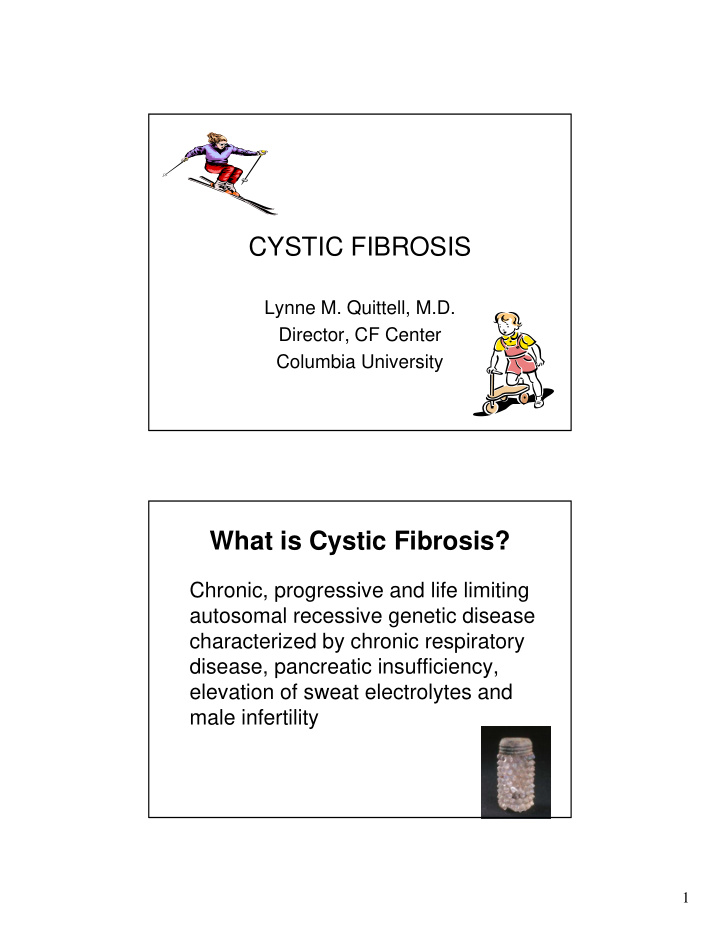



CYSTIC FIBROSIS Lynne M. Quittell, M.D. Director, CF Center Columbia University What is Cystic Fibrosis? Chronic, progressive and life limiting autosomal recessive genetic disease characterized by chronic respiratory disease, pancreatic insufficiency, elevation of sweat electrolytes and male infertility l i f tilit 1
“ Wehe dem Kind, das beim Kuss auf die Stirn salzig schmekt, er ist verhext und muss bald sterben” “Woe is the child who tastes salty from a kiss on the brow from a kiss on the brow, for he is for he is cursed , and soon must die” 2
Genetics of CF • Most common lethal genetic disease in Causasians 30,000 affected individuals in US 27,000 in Europe • CFTR - cAMP regulated chloride channel located in apical membrane of glandular epithelium – Encodes for a protein of 1480 amino acids p – Defective ion transport – Long arm of chromosome #7 • D508 most common mutation • > 1500 identified mutations 3
Ion Transport 4
The Cystic Fibrosis Airway Bacteria Mucociliary Clearance Clearance L Lysozyme Lactoferin, SLPI Phospholipase A2 Secretory IgA SP-A, SP-D, NO Mucus Phagocytic hBD-1, hBD-2, LL-3 Plug Cl- Cells Na+ CFTR Mucus NF κβ IL-8 Acquired Cl-Na+ Immunity Neutrophils Used with permission - R. Gibson, 2004. 5
6
The sweat test ( Chloride) Normal Normal Under 40 mEq/L Borderline 40-60 mEq/L Positive Over 60 mEq/L 7
CF: Pulmonary Disease Pathogenesis of Cystic Fibrosis Lung Disease CF Gene Mucous Plugging Abnormal Infection CFTR Inflammation Morbidity Mortality 8
Presentation (CF PANCREAS) C Chronic respiratory disease F F F il Failure to thrive t th i P Polyps A Alkalosis, metabolic N Neonatal intestinal obstruction C Clubbing of fingers R Rectal prolapse Electrolyte � in sweat E A Aspermia / absent vas deferens S Sputum – S.aureus/P.aeruginosa Airway Mucous Plugging, Infection, and Inflammation in Cystic Fibrosis Used with permission – J. Wagener, 2004. 9
Age Specific Prevalence of Respiratory Infections in CF Patients 100 P. aeruginosa 80 60 S. aureus 40 H. influenza MRSA 20 S. maltophilia B. cepacia 0 0 0 to 1 2 to 5 6 to 10 11 to 17 18 to 24 25 to 34 35 to 44 45+ Age (Years) P. aeruginosa 56.4% H. influenza 17.0% B. cepacia Complex 3.1% S. aureus 51.8% S. maltophilia 12.3% MRSA 17.2% Evidence of increased inflammation in BALF of infants with CF CF 2 25 80 Controls 20 60 15 % Neutrophils IL-8 (ng/ml) 40 10 20 20 5 0 0 Infected Uninfected Uninfected Infected (n = 23) (n = 27) (n = 23) (n = 28) Adapted from Muhlebach et al. Am J Respir Crit Care Med 1999; 160: 186-191. 10
11
CF Lung: End-Stage Bronchiectasis 2 3 1 CF Lung Function 12
Signs and Symptoms of Pulmonary Exacerbation • Increased cough • New chest findings – rales, wheezes rales wheezes • Increased sputum I d t • Decreased exercise • Weight loss tolerance • School/work • Decreased FEV1 absenteeism – down 10% • Increased dyspnea • New radiographic findings CF mild disease: CF mild disease: CF advanced disease: with hyperinflation, increased hyperinflation, increased bronchiectasis markings markings 13
High-Resolution Inspiratory and Expiratory CT Scan in 12 year old Used with permission - C. Milla, 2004. 14
15
CF: Pulmonary Complications CF: Respiratory management • Regular visits to CF Center • Airway clearance • Mucus thinners (DNase, hypertonic saline) • Antibiotics( PO-IV-Aerosol) • Anti inflammatory agents 16
Airway Clearance • CPT • Vest ISSUES • Reflux • Flutter • Adherence • ACB Airway Clearance • Chest Physical therapy • Vest – mechanical percussion p • Flutter, Acapella • Breathing techniques : ACB • Exercise 17
Mucolytic agents • Recombinant DNase • Hypertonic saline Treating Airway infections • Prophylactic treatment – prevent colonization • Exacerbations – improves lung function – reduces inflammation – decreases bacterial density decreases bacterial density • First isolates – may delay colonization 18
Antibiotics • Oral • IV • Aerosolized • Special Considerations: – Volume of distribution – Sensitivities – Drug Interactions – Side effects 19
Anti-inflammatory Rx • Steroids ISSUES – inhaled v oral inhaled v oral • Safety S f t • Ibuprofen • Adherence • Macrolides • ? Delay in progression of the disease Relative Change in FEV 1 % Predicted Day 168 Treatment Effect: Day 168 Δ : 5 6.21% (p=0.001) 4.44% 4 Azithromycin 2 0 Day 168 Δ : Placebo -1.77% -2 -4 0 28 84 168 196 Study Day 20
CF PFT’s CF: Gastrointestinal Disease • Pancreatic insufficiency/malabsorption • Lipo-soluble vitamin deficiency • Failure to thrive • Neonatal intestinal obstruction (15%) • Recurrent distal intestinal obstruction • Biliary stasis 21
CF: Pancreas- malabsorption 22
Median Predicted Survival Age, 1985-2005 (with 95 percent confidence bounds) 40 38 e (Years) 36 Median Survival Age 34 32 30 28 26 26 24 '85 '86 '87 '88 '89 '90 '91 '92 '93 '94 '95 '96 '97 '98 '99 '00 '01 '02 '03 '04 '05 Year As of August 2006, the median predicted survival is 36.5 years for 2005 . SUMMARY • Need to understand the pathophysiology of CF lung disease in young patients f CF l di i ti t • Need to understand the risk/benefit ratio of new treatments • Adherence • Window of opportunity Window of opportunity • Changing landscape 23
Recommend
More recommend